Ah, the sweet sound of vinyl! There’s something magical about dropping the needle on a record and hearing those warm, rich tones fill the room.
I’ll never forget the first time I experienced it – I was hooked instantly. But here’s the thing: choosing the right record player or turntable can be a bit overwhelming, especially if you’re just getting into the world of vinyl.
Trust me, I’ve been there, and I’ve made my fair share of mistakes along the way. That’s why I’m here to help you navigate this journey and find the perfect turntable for your needs.
Whether you’re a newbie or a seasoned audiophile looking to upgrade, I’ve got you covered. Let’s dive in and explore how to choose a record player or turntable that’ll make your vinyl collection sing!
How to Choose a Record Player or Turntable
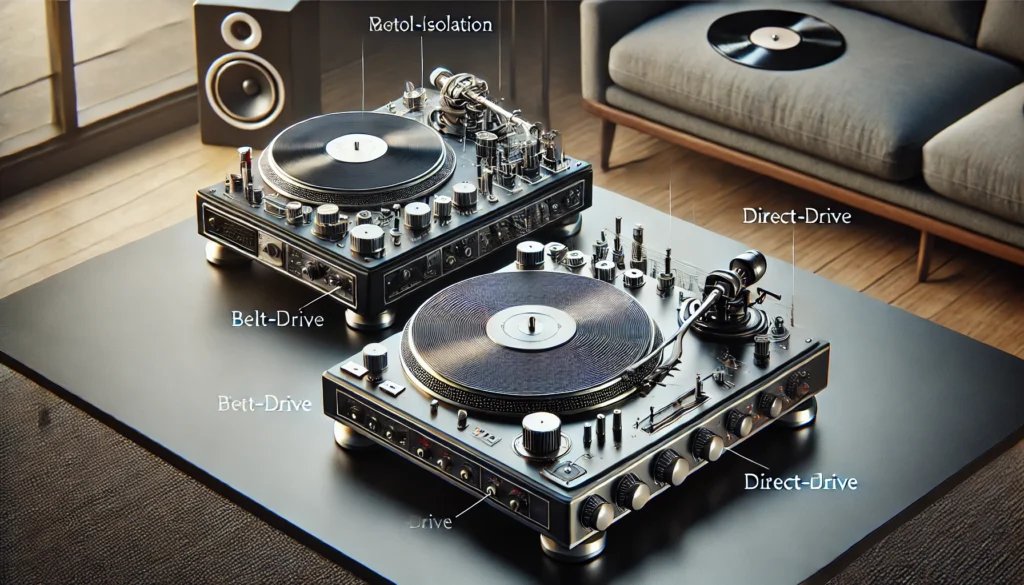
Choosing a record player or turntable boils down to understanding your needs, budget, and desired sound quality. First, consider the type of turntable – belt-drive for better isolation from motor noise, or direct-drive for precise speed control.
Look at key features like the platter material, tonearm design, and cartridge quality. Don’t forget to factor in your budget, as prices range from entry-level to high-end audiophile models.
Consider additional components you might need, like a preamp or speakers. Ultimately, the best choice depends on your listening preferences and how much you’re willing to invest in your vinyl setup.
We’ll explore these factors more deeply below, but remember – the perfect turntable is the one that brings you joy when you drop the needle!
Types of Record Players and Turntables
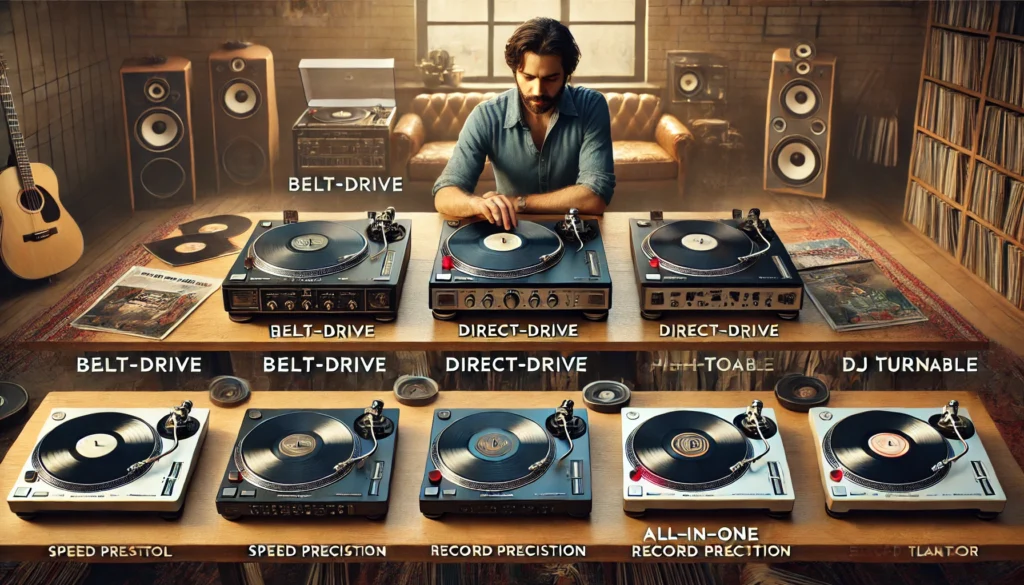
Alright, let’s break down the different types of record players and turntables out there. Trust me, knowing these distinctions can save you a lot of headaches (and money) down the road!
First up, we’ve got belt-drive turntables. These bad boys are my personal favorites for home listening.
Why? Well, they use a belt to connect the motor to the platter, which helps isolate the platter from motor vibrations. The result? A cleaner, more accurate sound.
I remember when I first switched from a cheap all-in-one player to a belt-drive – it was like hearing my records for the first time all over again!
Now, don’t get me wrong, direct-drive turntables have their place too. These have the motor directly connected to the platter, which gives you more consistent speed and faster start-up times.
They’re great for DJs who need to scratch and beat-match. I tried my hand at DJing once… let’s just say I’ll stick to home listening!
Then there are all-in-one record players. These are the jack-of-all-trades of the vinyl world.
They usually come with built-in speakers and sometimes even Bluetooth connectivity. They’re convenient, especially if you’re tight on space or just dipping your toes into vinyl.
But here’s the catch – they often sacrifice sound quality for convenience. I started with one of these, and while it was fun, I quickly found myself craving better sound.
Lastly, we’ve got DJ turntables. These are the tanks of the turntable world – built to withstand heavy use and designed for mixing and scratching.
They’re usually direct-drive and have features like pitch control and high torque motors. Unless you’re planning on becoming the next big thing in the club scene, these might be overkill for home use.
Remember, there’s no one-size-fits-all solution. The best type for you depends on your listening habits, space, and budget.
Don’t be afraid to visit a local hi-fi shop and listen to different types – your ears will thank you!
Key Features to Consider
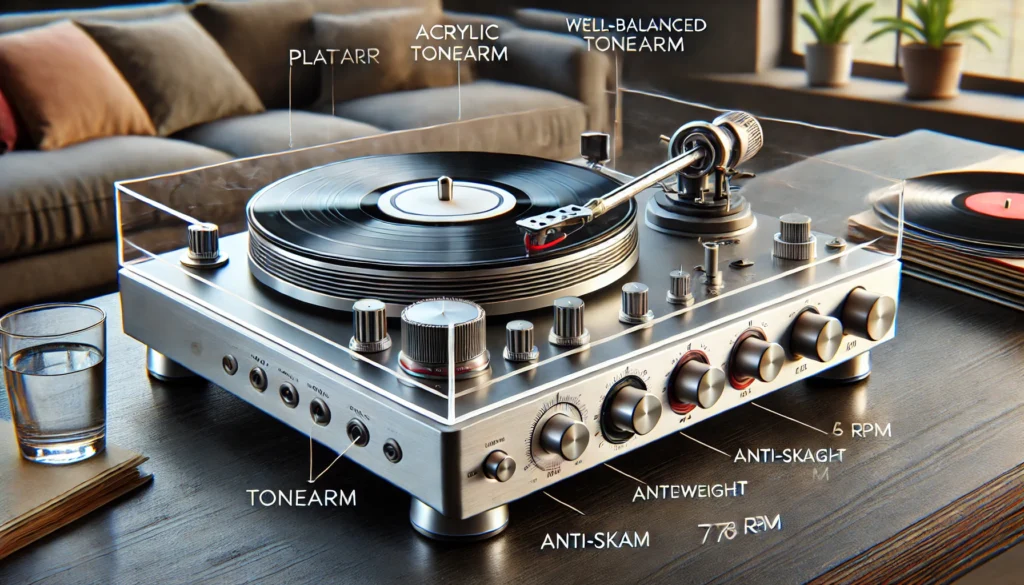
When it comes to choosing a record player or turntable, there are some key features you’ll want to keep an eye on. Trust me, I’ve learned the hard way that overlooking these can lead to some serious buyer’s remorse!
First up, let’s talk about the platter. This is the circular platform that your record sits on, and it’s more important than you might think.
Materials like aluminum or acrylic can help reduce resonance and improve sound quality. I remember upgrading from a plastic platter to an acrylic one – the difference was like night and day!
Next, we’ve got the tonearm. This is the arm that holds the cartridge and tracks the record grooves.
Look for a well-balanced tonearm with adjustable counterweight and anti-skate. Getting these settings right can be a bit fiddly (I spent a whole afternoon once trying to perfect mine), but it’s worth it for the improved sound and reduced record wear.
Speaking of cartridges, this little guy is where the magic happens. It’s the device at the end of the tonearm that holds the stylus (needle) and converts the physical grooves into an electrical signal.
A good cartridge can make a world of difference. I once splurged on a high-end cartridge, and let me tell you, it was like hearing my favorite albums for the first time all over again!
Don’t forget about speed options. Most turntables offer 33 1/3 and 45 RPM, which covers most vinyl records.
But if you’ve got some oldies in your collection, you might want to look for one that also plays at 78 RPM. Just be careful not to accidentally play your 33s at 45 like I did once – everything sounded like Alvin and the Chipmunks!
Lastly, consider whether you want a built-in preamp. If you’re planning to connect directly to powered speakers or an amplifier without a phono input, a built-in preamp can be super convenient.
But if you’re an audiophile looking for maximum flexibility, you might prefer an external preamp. I started with a built-in preamp and later upgraded to an external one – the improvement in sound quality was noticeable, but it did mean more cables and gear to manage.
Remember, these features all work together to create your listening experience. It’s not about ticking every box, but finding the right combination that works for your needs and budget.
And hey, half the fun is in the journey of discovering what you like!
Budget Considerations
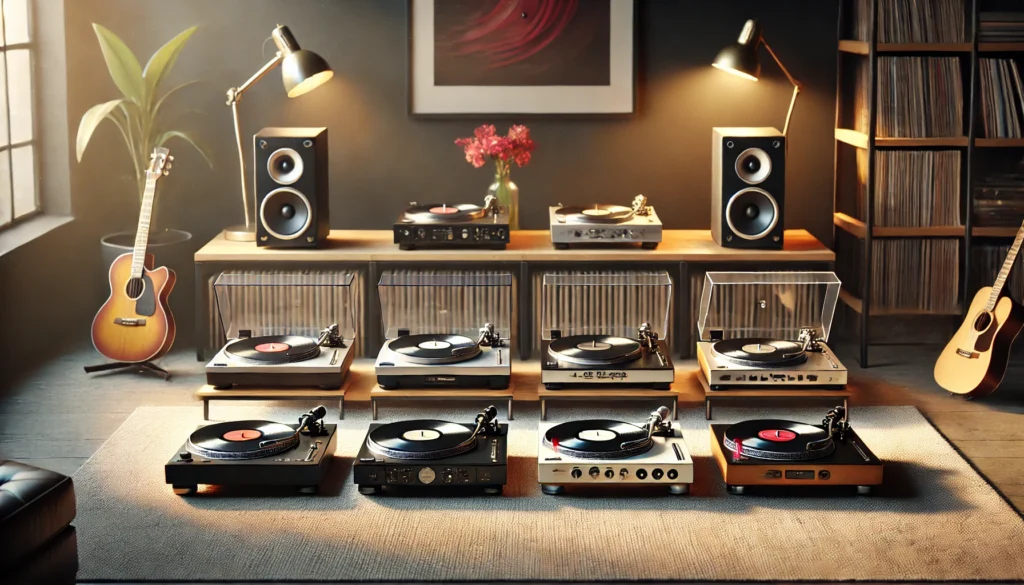
Let’s talk money, honey! Choosing a record player or turntable can be a bit like buying a car – there’s a wide range of options at different price points, and it’s easy to get carried away.
But don’t worry, I’ve been there, and I’m here to help you navigate the financial waters of vinyl playback.
Starting at the entry-level, you can find decent turntables for around $100-$300. These are great for beginners or casual listeners.
They might not have all the bells and whistles, but they’ll get you spinning vinyl without breaking the bank. I started with one of these, and you know what? It was perfect for getting my feet wet in the world of vinyl.
Moving up to the mid-range, we’re looking at $300-$1000. This is where things start to get interesting.
You’ll find better build quality, improved cartridges, and more precise speed control. It’s also where you might start to notice significant improvements in sound quality.
I remember upgrading to a mid-range turntable and being blown away by how much clearer and more detailed my records sounded.
Now, if you’ve got deep pockets and a serious passion for audio quality, there’s the high-end audiophile market. We’re talking $1000 and up, way up.
These turntables are the crème de la crème, with precision engineering, exotic materials, and top-of-the-line components. I once had the chance to listen to a ultra-high-end turntable at a hi-fi show, and let me tell you, it was a religious experience!
But here’s the thing – more expensive doesn’t always mean better for you. It’s all about finding the sweet spot where your budget meets your ears’ satisfaction.
And remember, the turntable is just one part of the equation. You’ll also need to factor in the cost of speakers, amplifiers, and maybe even some room treatment if you’re going all out.
My advice? Start with what you can comfortably afford, and upgrade over time as your passion (and budget) grows. There’s no shame in starting small – every vinyl enthusiast has been there.
And hey, half the fun is in the journey of upgrading and discovering new levels of sound quality along the way!
Additional Components and Accessories
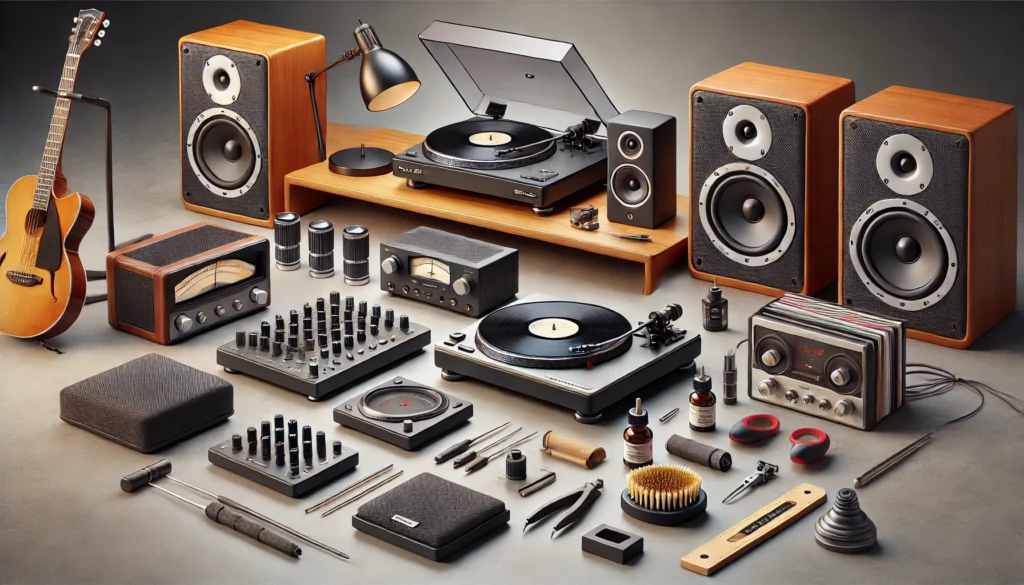
Alright, let’s talk about the supporting cast in your vinyl setup. These additional components and accessories can make or break your listening experience.
Trust me, I’ve learned this through plenty of trial and error!
First up, speakers and amplifiers. These are crucial – even the best turntable in the world won’t sound great through poor speakers.
I started with some basic bookshelf speakers and a budget amp, and they were fine to begin with. But when I upgraded to a pair of floor-standing speakers and a decent integrated amp? Mind. Blown.
Just remember, you don’t need to break the bank right away. Start with what you can afford and upgrade over time.
Next, let’s talk about phono preamps. If your turntable or amplifier doesn’t have a built-in phono stage, you’ll need one of these.
It boosts the tiny signal from your cartridge to a level that your amp can work with. I used to think all preamps were created equal until I borrowed a friend’s high-end model.
The improvement in clarity and detail was eye-opening!
Cartridge upgrades can be a game-changer too. The cartridge that comes with your turntable is usually decent, but upgrading can really elevate your listening experience.
I remember the first time I splurged on a good cartridge – suddenly, I was hearing details in my favorite albums that I’d never noticed before. Just be careful when installing it – I may or may not have accidentally bent a stylus during my first attempt (oops!).
Now, onto cleaning tools and accessories. These might seem boring, but they’re essential for keeping your vinyl and equipment in top shape.
A good carbon fiber brush is a must for removing dust before each play. And don’t get me started on the joys of a record cleaning machine – it’s like sending your vinyl to a spa! I used to think my old records were just noisy, but after a proper cleaning, they sounded almost new.
Other accessories to consider include a stylus pressure gauge for ensuring the correct tracking force, a bubble level for properly setting up your turntable, and maybe even some isolation feet to minimize vibrations.
Oh, and if you really want to go down the rabbit hole, look into record weights or clamps. They can help flatten warped records and improve overall sound quality.
Remember, you don’t need to buy everything at once. Build your setup gradually, and enjoy the process of discovery.
Each new component or accessory is an opportunity to fall in love with your music all over again. Happy listening!
Sound Quality and Performance
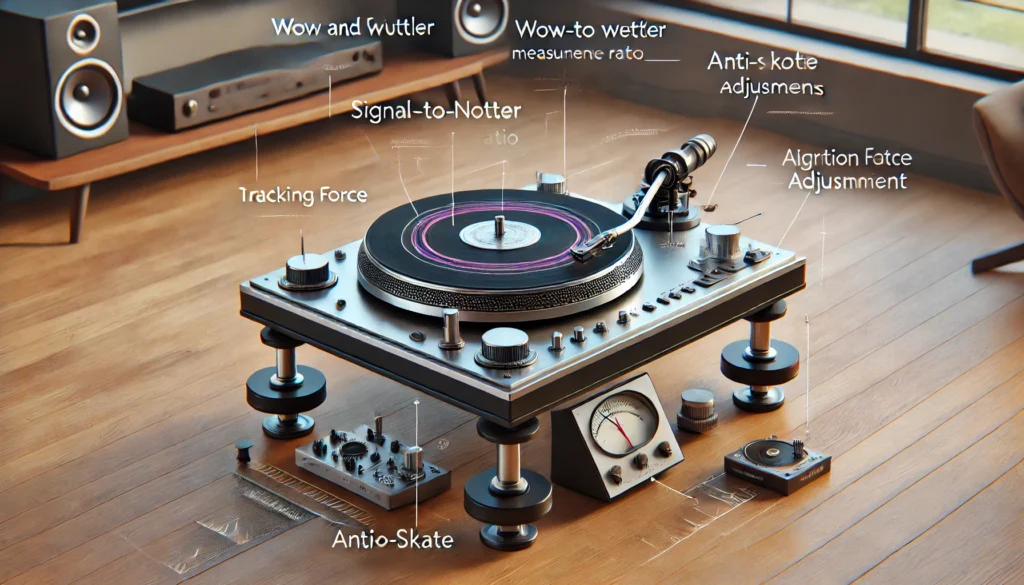
Let’s dive into the nitty-gritty of sound quality and performance. This is where things get really exciting – and sometimes a bit technical.
But don’t worry, I’ll break it down in a way that won’t make your head spin!
First up, we’ve got wow and flutter. No, it’s not a new indie band – it’s a measure of speed consistency.
Wow refers to slower speed variations, while flutter is about faster ones. Both can make your music sound wobbly or off-pitch.
I once had a turntable with bad wow and flutter, and listening to piano recordings was like being on a nauseating carnival ride!
Then there’s the signal-to-noise ratio. This is all about how much of what you’re hearing is music versus unwanted noise.
A higher ratio means cleaner sound. I remember upgrading my phono preamp and being amazed at how much quieter the background was – it was like cleaning a dirty window and suddenly seeing the view clearly.
Now, let’s talk about tracking force and anti-skate adjustments. These are crucial for getting the best sound and protecting your records.
Tracking force is how heavily your stylus sits in the groove, while anti-skate counteracts the tendency of the tonearm to move inward. Getting these right can be a bit fiddly – I spent a whole afternoon once with a tracking force gauge, trying to get it just perfect.
But trust me, it’s worth it for the improved sound quality and reduced record wear.
Another factor to consider is the turntable’s ability to reject external vibrations. This is where things like the plinth (the base of the turntable) and the feet come into play.
I learned this the hard way when I first set up my turntable near my washing machine – every spin cycle turned my listening session into a remix!
And let’s not forget about cartridge alignment. This ensures that your stylus is tracking the groove accurately.
There are alignment protractors you can use for this, and while it might seem like you need an engineering degree to get it right (I certainly felt that way at first), the improvement in sound quality is worth the effort.
Remember, achieving great sound quality is a journey, not a destination. It’s about finding the right balance for your ears and your budget.
Don’t get too caught up in the numbers and specs – at the end of the day, if it sounds good to you, that’s what matters most. Happy listening!
Maintenance and Care
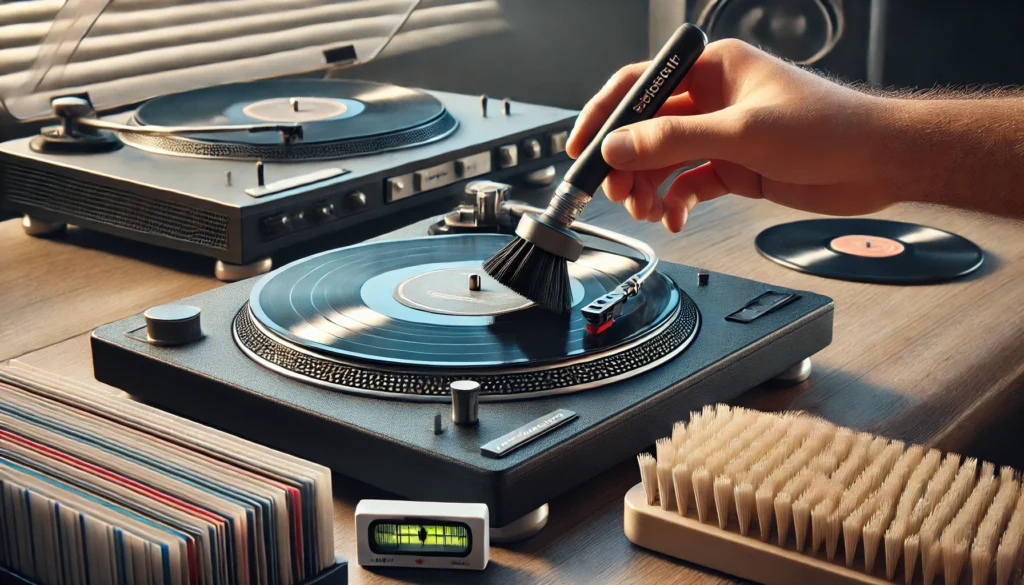
Alright, let’s talk about keeping your vinyl setup in tip-top shape. Proper maintenance and care can make a world of difference in both sound quality and the longevity of your equipment.
Trust me, I’ve learned some of these lessons the hard way!
First things first: proper setup and alignment. This is crucial for getting the best sound and protecting your records.
I remember the first time I set up a turntable – I was so excited that I rushed through it, only to wonder why everything sounded off. Take your time with this step.
Make sure your turntable is level (use a bubble level if you have one), set the tracking force and anti-skate correctly, and align your cartridge properly. It might seem tedious, but your ears (and your records) will thank you.
Now, let’s talk about cleaning. Both your records and your stylus need regular cleaning to sound their best.
For records, invest in a good carbon fiber brush and use it before and after each play. Trust me, once you get into the habit, it becomes second nature.
For deeper cleaning, consider a record cleaning solution and maybe even a record cleaning machine if you’re really serious (or have a lot of dusty old records like I did).
As for the stylus, a gentle brush designed for this purpose works wonders. Just remember to brush from back to front, never side to side or you might damage it.
I learned that lesson the hard way once – let’s just say I had to replace a cartridge sooner than expected!
Storage is another crucial aspect of vinyl care. Always store your records vertically to prevent warping.
I once left a record lying flat under a pile of books, and well… it didn’t end well. Use inner sleeves to protect against dust and static, and outer sleeves for additional protection.
And please, whatever you do, don’t stack your records horizontally – future you will be very upset!
Now, let’s talk about stylus replacement. This is something that often gets overlooked, but it’s super important.
A worn stylus can damage your records and sound terrible. How often you need to replace it depends on usage, but a general rule of thumb is every 1000 hours of play time.
I once pushed mine way past its prime, and when I finally replaced it, it was like hearing my records for the first time all over again!
Don’t forget about your turntable itself. Keep it dust-free with a soft, dry cloth.
If you’re not using it, keep the dust cover on. And here’s a pro tip: if you’re moving your turntable, even just a short distance, remove the platter and secure the tonearm.
I once didn’t do this and… well, let’s just say I had to do some recalibrating afterwards.
Lastly, be mindful of your turntable’s environment. Keep it away from sources of vibration (like speakers or foot traffic), direct sunlight, and extreme temperatures.
I once set up my turntable right next to a window – big mistake. The temperature fluctuations wreaked havoc on my listening experience.
Remember, a little bit of regular maintenance goes a long way. It might seem like a chore at first, but trust me, it becomes a enjoyable ritual.
There’s something deeply satisfying about caring for your vinyl setup, knowing that you’re preserving your music for years to come.
Conclusion
Whew! We’ve covered a lot of ground, haven’t we? From choosing the right type of turntable to maintaining your vinyl setup, there’s certainly a lot to consider when diving into the world of record players.
But don’t let that intimidate you – remember, this is all about enjoying music in one of its most pure and engaging forms.
Whether you’re just starting out with a budget-friendly option or you’re ready to invest in a high-end audiophile setup, the key is to find a turntable that suits your needs and brings you joy.
After all, there’s nothing quite like the ritual of selecting a record, gently lowering the needle, and being transported by the warm, rich sound of vinyl.
As you embark on your vinyl journey, don’t be afraid to experiment and upgrade
